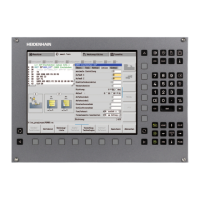January 2012 7.4 Switching the Control On/Off 1313
7.4 Switching the Control On/Off
7.4.1 Powering up the control
Start-up sequence The control start-up comprises several phases, which are briefly described
below. The points where OEMs can influence the start-up directly through
entries or macros are described in detail.
Start-up sequence of the control:
Step 1: BIOS loading process
The BIOS stored in the EPROM of the MC main computer is loaded. BIOS
stands for Basic Input Output System. The BIOS also checks the installed
main memory and the individual peripherals.
Step 2: HeROS boot process
After the BIOS is loaded the control starts the HEIDENHAIN HeROS
operating system (HEIDENHAIN Real-time Operating System).
Step 3: Start the NC software
HeROS starts the NC software. The start-up screen appears on the control
monitor as well as a dialog box showing the number of the currently loaded
process. During start-up the control reads the config data from the *.cfg
files. If the configuration contains errors or, for example, new and therefore
yet uninitialized parameters from a software update, the boot process is
interrupted. The code number dialog box appears. Enter the MP code
number 95148 to open the configuration editor. All new or changed
parameters are indicated by a red exclamation mark in the editor. Press the
SAVE soft key to save the changed configuration and exit the configuration
editor. The control then resumes the start-up sequence of the NC software.
Step 4: Acknowledge the power interruption
If so configured with MP_powerInterruptMsg, see page 1314, the control
waits until you confirm the Power interrupted message by pressing the CE
key. If the machine configuration is incorrect, the power interruption can
only be acknowledged after you have corrected the configuration.
Step 5: Compile the PLC program
After you press the CE key, the control compiles the PLC program and
displays the Compiling the PLC program message. If the PLC program
cannot be successfully compiled, you can view the errors in the PLC
compiler's status window, contained in the editor of the PLC Programming
operating mode.
Step 6: Configure the CC controller unit (only digital control)
The interpolator configures the CC controller unit and starts the DSPs. If
errors occur, they are displayed in the error window (ERR key).
Step 7: Test the EMERGENCY STOP
Once the CC controller unit reports its readiness, the control starts the
EMERGENCY STOP test. For more information on the process, see
"Emergency stop monitoring" on page 989.
Step 8: Run the start-up cycle
The start-up cycle is run three times in total—once for the Program Run
operating modes, once for the Test Run mode, and once for the
Programming and Editing mode. During execution the control displays the
message Control is being initialized. After the control start-up, the
start-up cycle establishes a defined control condition.
Step 9: Traverse the reference marks (if configured)
In the last step, the control displays the Traverse reference points
message prompting the operator to scan the reference marks in the axes.
Then the start-up of the control is complete. The Traverse Reference Marks
mode cannot be exited until all axes have been successfully referenced.

